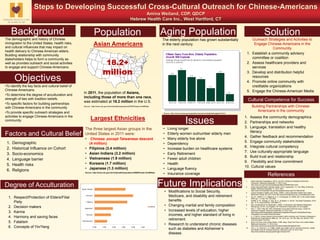Steps to Developing Successful Chinese-Americans_Weiland
•Als PPTX, PDF herunterladen•
1 gefällt mir•85 views
The document outlines steps for developing successful outreach to Chinese-Americans. It discusses key factors including the demographic and history of Chinese immigration, cultural beliefs that impact health like respect for elders and concepts of Yin and Yang. The three largest Asian groups in the US are Chinese, Filipinos, and Asian Indians. Suggested outreach strategies include establishing community partnerships, assessing healthcare services, developing resources, and engaging media. Building trust and understanding cultural values are important for effective outreach and engagement with Chinese-American communities.
Melden
Teilen
Melden
Teilen

Empfohlen
Empfohlen
Weitere ähnliche Inhalte
Andere mochten auch
Andere mochten auch (10)
Engaging with the Global, High Net Worth Chinese Consumer: How Luxury Brands ...

Engaging with the Global, High Net Worth Chinese Consumer: How Luxury Brands ...
Ähnlich wie Steps to Developing Successful Chinese-Americans_Weiland
Ähnlich wie Steps to Developing Successful Chinese-Americans_Weiland (20)
Running head CULTURALLY RELEVANT RESEARCH APPROACHES1CULTURALL.docx

Running head CULTURALLY RELEVANT RESEARCH APPROACHES1CULTURALL.docx
Please read each attachment for instructions, please answer each q.docx

Please read each attachment for instructions, please answer each q.docx
Please read each attachment for instructions, please answer each q.docx

Please read each attachment for instructions, please answer each q.docx
Policy Debates and Indigenous Education: The Trialectic of Language, Culture,...

Policy Debates and Indigenous Education: The Trialectic of Language, Culture,...
Communication strategies for_the_aa_and_nhpi_m_nitta_final

Communication strategies for_the_aa_and_nhpi_m_nitta_final
Comment on “Beyond Assimilation and Nationalism: Walking in Two Worlds Is Nec...

Comment on “Beyond Assimilation and Nationalism: Walking in Two Worlds Is Nec...
NRSE 4570 Ohio University Comprehensive Cultural Assessment Essay.pdf

NRSE 4570 Ohio University Comprehensive Cultural Assessment Essay.pdf
Steps to Developing Successful Chinese-Americans_Weiland
- 1. Steps to Developing Successful Cross-Cultural Outreach for Chinese-Americans Amina Weiland, CDP, QDCP Hebrew Health Care Inc., West Hartford, CT Background Factors and Cultural Belief References Objectives Population Cultural Competence for Success •To identify the key facts and cultural belief of Chinese-Americans. •To determine the degree of acculturation and strength of ties with tradition beliefs. •To specific factors for building partnerships with Chinese-Americans in the community •To provide specific outreach strategies and activities to engage Chinese-Americans in the community Solution Issues 1. Asian American Populations. (2013, July 02). Centers for Disease Control and Prevention. Retrieved December 17, 2013, from http://www.cdc.gov/minorityhealth/populations/REMP/asian.html 2. Asian American/Pacific Islander Profile. (2012, September 17). The Office of Minority Health. Retrieved December 17, 2013, from http://www.minorityhealth.hhs.gov/templates/browse.aspx?lvl=3&lvlid=29 3. Culture-Sensitive Health Care: Asian. (2000). Culture-Sensitive Health Care: Asian. Retrieved October 29, 2013, from http://www.diversityresources.com/health/asian.html 4. He, W., Velkoff, V. A., DeBarros, K. A., & Sengupta, M. (2005). 65+ in the United States: 2005 (pp. 1-4, Rep. No. P23-209). 5. Hoeffel, E. M., Rastogi, S., Kim, M. O., & Shahid, H. (2012). The Asian Population: 2010 (pp. 14-15, Issue brief No. C2010BR-11). 6. Key Considerations for Replication. (2004). In Dementia Care Network Replication Manual (pp. 33-34). Los Angeles, CA: Alzheimer's Association of Los Angeles. 7. Kieu, T. (2013, May 28). Why Immigration Is an Asian American Issue. Center for American Progress. Retrieved December 10, 2013, from http://www.americanprogress.org/issues/immigration/news/2013/05/28/64474/why- immigration-is-an-asian-american-issue/ 8. Li, Y. (2012). Cross-Cultural Communication within American and Chinese Colleagues in Multinational Organizations (68th ed., Vol. 2010, pp. 114-129, Rep. No. Article 7). NY: Communication Common. 9. Sixty-Five Plus in the United States. (1995, May). Sixty-Five Plus in the United States. Retrieved December 17, 2013, from http://www.census.gov/population/socdemo/statbriefs/agebrief.html 10. Tom, L. S., & Burns, J. A. (1998). Health and Health care for Chinese American. Health and Health Care for Chinese American. Retrieved June 10, 2013, from http://www.stanford.edu/group/ethnoger/chinese.html 1. Demographic 2. Historical Influence on Cohort 3. Socio-economics 4. Language barrier 5. Health risks 6. Religions Largest Ethnicities The demographic and history of Chinese immigration to the United States, health risks, and cultural influences that may impact on health delivery to Chinese American elders. Building relationship with community stakeholders helps to form a community as well as provides outreach and social activities to engage and support Chinese-Americans. Asian Americans Outreach Strategies and Activities to Engage Chinese-Americans in the Community 1. Establish a community advisory committee or coalition 2. Assess healthcare providers and services 3. Develop and distribution helpful resources 4. Promote online community with creditable organizations 5. Engage the Chinese-American Media The three largest Asian groups in the United States in 2011 were: • Chinese ,except Taiwanese descent (4 million) • Filipinos (3.4 million) • Asian Indians (3.2 million) • Vietnamese (1.9 million) • Koreans (1.7 million) • Japanese (1.3 million) Source: http://www.cdc.gov/minorityhealth/populations/REMP/asian.html#Stats 18.2+ million Degree of Acculturation 1. Respect/Protection of Elders/Filial Piety 2. Decision makers 3. Karma 4. Harmony and saving faces 5. Fatalism 6. Concepts of Yin/Yang In 2011, the population of Asians, including those of more than one race, was estimated at 18.2 million in the U.S. Source: http://www.cdc.gov/minorityhealth/populations/REMP/asian.html#Stats Aging Population Building Partnerships with Chinese- Americans in the community 1. Assess the community demographics 2. Partnerships and networks 3. Language, translation and healthy literacy 4. Gather feedback and recommendation 5. Engage community stakeholders 6. Integrate cultural competency 7. Use culturally-appropriate language 8. Build trust and relationship 9. Flexibility and time commitment 10. Cultural values The elderly population has grown substantially in the next century. Source: http://www.census.gov/population/socdemo/statbriefs/agebrief.html • Living longer • Elderly women outnumber elderly men • Many elderly live alone • Dependency • Increase burden on healthcare systems • Early Retirement • Fewer adult children • Health • Language fluency • Insurance coverage Future Implications • Modifications to Social Security, Medicare, and disability and retirement benefits • Changing martial and family composition • Increased levels of education, higher incomes, and higher standard of living in retirement. • Research to understand chronic diseases such as diabetes and Alzheimer’s disease.